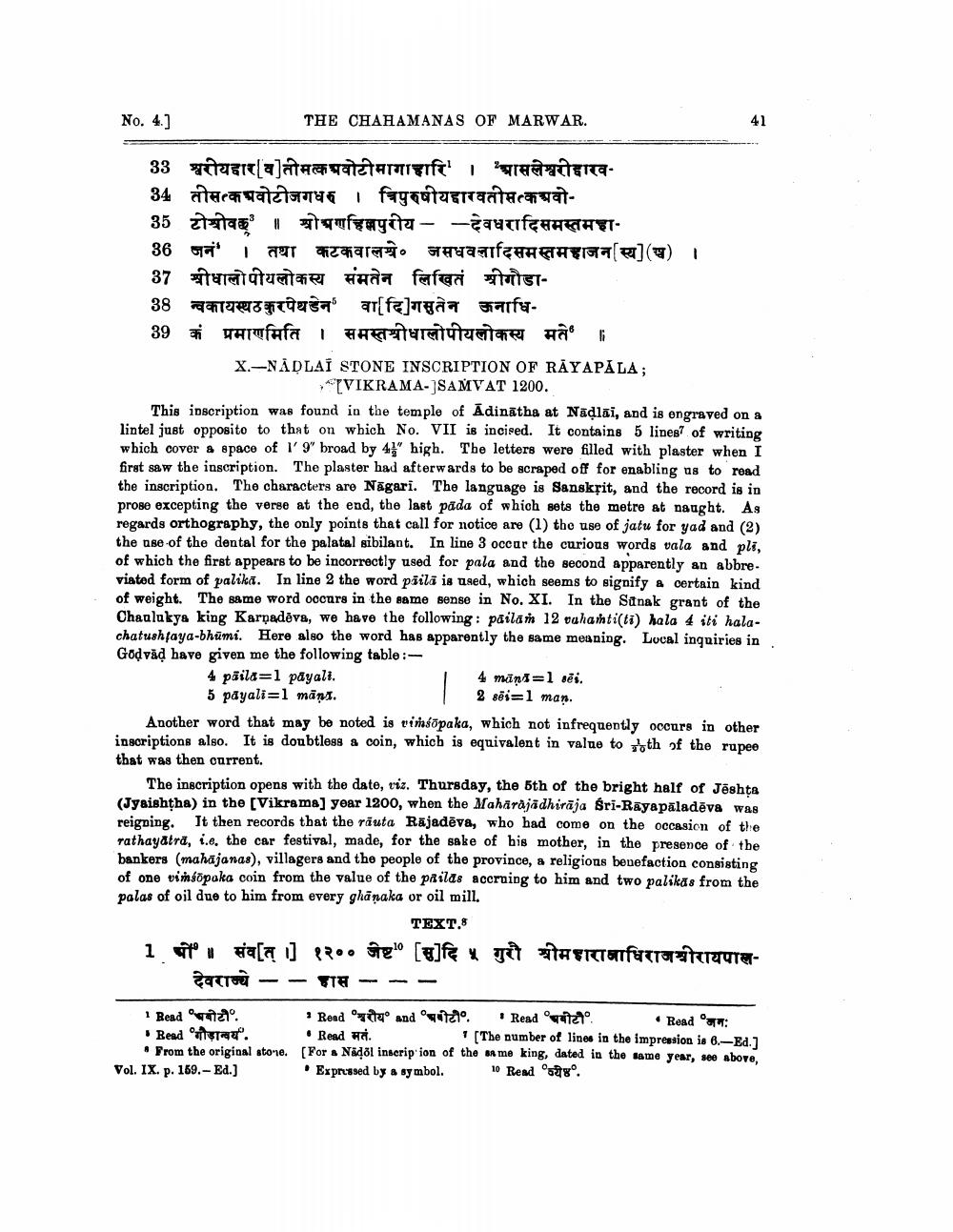________________
No. 4.]
33 वरीयार [व] तीमत्क अवोटी मागाहारि' । 'आसलेश्वरीहारव34 तीसत्कचवोटीजगधर । चिपुरुषीयदारवतीसको
35 टोयोव' । श्रोषणणिपुरीय – देवधरादिसमस्त महा
।
36 जनं । तथा कटकवालये असभवतादिसमस्तमहाजन [य] (च) 37 श्रीधालोपोथलोकस्य संमतेन लिखितं श्रीगोडा
वा[दि]गस्तेन जनाधि
THE CHAHAMANAS OF MARWAR.
38 वकायस्थ ठकुरपेथडेन'
39 कं प्रमाणमिति । समस्तश्रीधालोपीयलोकस्य मते'
X.-NADLAI STONE INSCRIPTION OF RAYAPALA; [VIKRAMA-SAMVAT 1200.
-
4 paila 1 payali.
5 payali 1 maṇī.
This inscription was found in the temple of Adinatha at Näḍlai, and is engraved on a lintel just opposito to that on which No. VII is incised. It contains 5 lines of writing which cover a space of 1' 9" broad by 41" high. The letters were filled with plaster when I first saw the inscription. The plaster had afterwards to be scraped off for enabling us to read the inscription. The characters are Nagari. The language is Sanskrit, and the record is in prose excepting the verse at the end, the last pada of which sets the metre at naught. As regards orthography, the only points that call for notice are (1) the use of jatu for yad and (2) the use of the dental for the palatal sibilant. In line 3 occur the curious words vala and pli, of which the first appears to be incorrectly used for pala and the second apparently an abbre viated form of palika. In line 2 the word päilä is used, which seems to signify a certain kind of weight. The same word occurs in the same sense in No. XI. In the Sunak grant of the Chaulukya king Karpadeva, we have the following: pailam 12 vahamti(ti) hala 4 iti halachatushtaya-bhumi. Here also the word has apparently the same meaning. Local inquiries in Göḍvāḍ have given me the following table:
1 Bead.
• Read 'गौड़ान्वर्य'.
From the original stone.
1
Vol. IX. p. 159.-Ed.]
41
4 mānī=1 sēi. 2 sei=1 man.
Another word that may be noted is vimsopaka, which not infrequently occurs in other inscriptions also. It is doubtless a coin, which is equivalent in value to th of the rupee that was then current.
The inscription opens with the date, viz. Thursday, the 5th of the bright half of Jeshṭa (Jyaishtha) in the [Vikrama] year 1200, when the Mahārājādhiraja Sri-Rayapaladeva was reigning. It then records that the rauta Rajadeva, who had come on the occasion of the rathayatra, i.e. the car festival, made, for the sake of his mother, in the presence of the bankers (mahajanas), villagers and the people of the province, a religions benefaction consisting of one vimsopaka coin from the value of the pailas accrning to him and two palikas from the palas of oil due to him from every ghanaka or oil mill.
TEXT.8
1 ओं ॥ संव[त् ।] १२०० जेष्ट " [स]दि ५ गुरौ श्रीमहाराजाधिराज श्रीरायपालदेवराज्ये
- हास
• Read 'मोटो'
Read
:
• Read वरीय° and बोटी • Read मतं. [The number of lines in the impression is 6.-Ed.] [For a Nädöl inscrip ion of the same king, dated in the same year, see above, Expressed by a symbol. 10 Read 8°.




